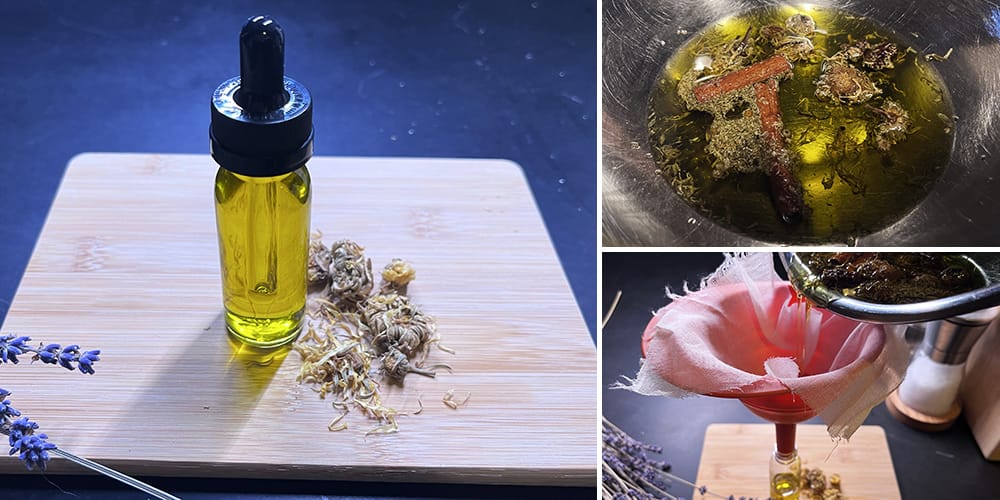
DIY Antifungal Oil
This antifungal oil recipe combines olive oil with the healing properties of calendula, echinacea, and cinnamon to create a potent topical treatment for thrush and other fungal infections. This blend also has skin-soothing properties and can be used to support general skin healing. So, let’s dive in!
What is a Fungal Infection?
Fungal infections, caused by various types of fungi, can affect different parts of the body, leading to a range of health issues. One common type is dermatophytosis, affecting the skin, hair, and nails. Athlete’s foot, ringworm, and jock itch are examples of dermatophytosis.
Candidiasis is another prevalent fungal infection caused by the Candida species, commonly affecting the mouth (oral thrush) and genital areas (yeast infections). Aspergillosis, often found in the lungs, is caused by inhaling spores of the Aspergillus fungus.
Onychomycosis targets the nails, resulting in discoloration and thickening. Additionally, systemic fungal infections can spread throughout the body, posing serious health risks, especially for individuals with weakened immune systems. Treatment typically involves antifungal medications, and preventive measures include maintaining good hygiene and avoiding environments conducive to fungal growth.
The Herbs in My Antifungal Oil Recipe
Calendula, commonly known as marigold, possesses impressive antifungal properties that make it a popular natural remedy for various fungal infections. The active compounds found in calendula, such as flavonoids and triterpenoids, have been shown to inhibit the growth of fungi like Candida albicans and Aspergillus niger. These compounds work by disrupting the cell membranes of the fungi, leading to their eventual death. Calendula extracts can be applied topically to treat skin conditions like athlete’s foot or ringworm, providing relief from itching and inflammation while combating the underlying fungal infection.
Echinacea, a popular herb known for its immune-boosting properties, also possesses impressive antifungal abilities. Echinacea has been shown to be effective against various fungal infections by inhibiting the growth and spread of fungi. This natural remedy works by disrupting the cell walls of fungi, ultimately leading to their destruction. Studies have demonstrated that Echinacea can combat common fungal infections such as candida and athlete’s foot.
⇒ Get your own Calendula & Echinacea seeds, last 30 packs left!
Cinnamon, a versatile spice commonly used in cooking and baking, is known for its antifungal properties. This means that it can help inhibit the growth of fungi such as yeast and mold. The active ingredient in cinnamon responsible for this effect is cinnamaldehyde. When applied topically or ingested, cinnamaldehyde works by disrupting the cell membranes of fungi, preventing them from reproducing and spreading. Studies have shown that cinnamon can be effective against various types of fungal infections, including those affecting the skin, nails, and respiratory system.
If you don’t have any antifungal herbs on hand, don’t worry, you can head to your pantry and surely you will find useful alternatives there. I personally got rid of fungal infections for good by preparing garlic as learned from The Holistic Guide to Wellness.
DIY Antifungal Oil
Ingredients:
- ½ cup extra virgin olive oil
- 2 tbsp dried calendula flowers
- 2 tbsp dried echinacea flowers
- 1 cinnamon stick
Instructions:
- Use a double-boiler or create one by placing a metal bowl over a pot with 1-2 inches of simmering water. This allows your oil to infuse without burning the herbs.

- Pour the olive oil into your double boiler.

- Add the calendula, echinacea, and cinnamon to the oil, and make sure all herbs are completely submerged.

- Allow the oil to infuse over heat for 2-3 hours. Your oil will become slightly darker and begin to smell like herbs when it’s done.
- Remove the oil from heat and allow to cool to room temperature, for about 40 minutes.
- Gently pour the oil through some cheesecloth into a small jar. You may want to use a funnel to do this. Gently squeeze the herbs through the cheesecloth to get as much of the oil out as possible.

- Label your jar with the date and list of ingredients.

How to Use
You can store the oil in a cool dark place for 6 months, or up to a year in the fridge.
This antifungal oil can be applied directly to the skin on areas that are affected by fungal infections. Apply 2-3 times per day until you see improvement.
Additionally, this oil works well on damaged skin and helps it heal from cuts and scrapes due to the antibacterial and antiseptic properties of the ingredients.
You can store the oil in a cool dark place for up to a year in the fridge.

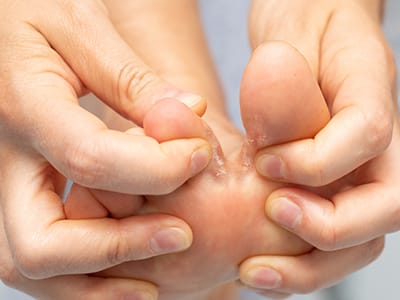
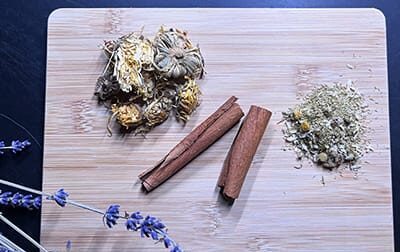
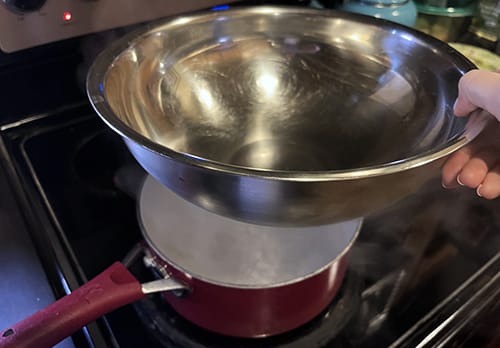
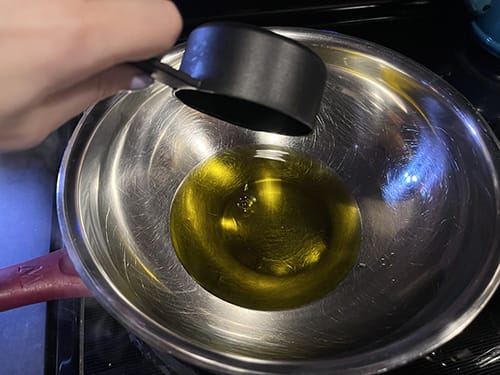
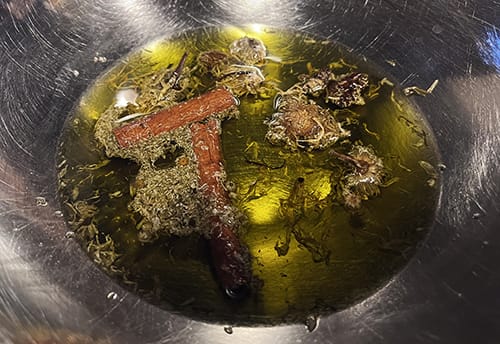
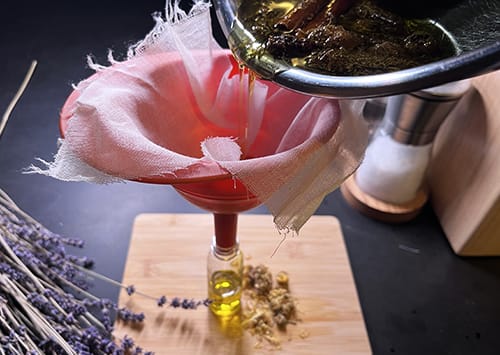
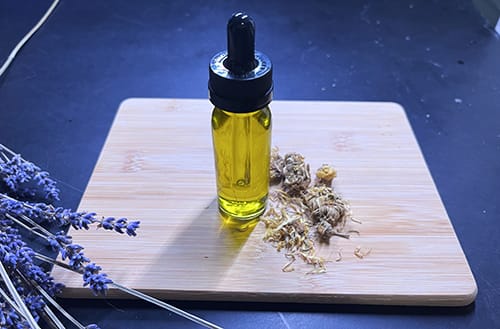
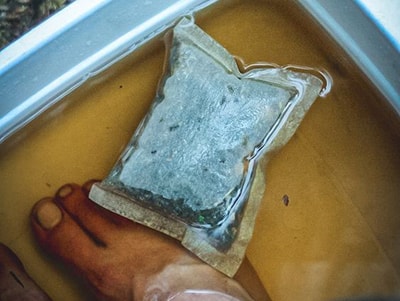
Does this oil also help with toenail fungus?
Hi Rion,
You can give it a try. We also have another article that might be useful to you:
https://thelostherbs.com/diy-antifungal-powder-for-toenail-fungus/
I hope this helps.
Many blessings and good health!
Can you use coconut oil as it also has beneficial properties…???
Hi SJ,
Yes, coconut oil is a great alternative.
Many blessings and good health!
Do you know of anything that helps with warts?
Buckthorn Bark acete topically then with calendula oil or salve.
Hi O.B
You could also try diluted tea tree oil, apple cider vinegar, or garlic poultice.
Also, these articles might be useful for you:
https://thelostherbs.com/how-to-get-rid-of-warts-with-duct-tape/
https://thelostherbs.com/natural-remedies-for-stubborn-hpv/
Many blessings and good health!
Tea tree oil works perfectly well with both Onychomycosis/Tinea Unguium (nail fungus) and Tinea Pedis (Athletes foot)
Yes, tea tree oil works great against toenail fungus. It worked for me.
Hi Doris,
Thank you for your advice!
Tea tree oil is indeed a powerful antifungal.
Many blessings and good health!
Hi, would this be a/effective(?) against tinea versicolor?
Hi James,
You can try it and see how you react to this remedy.
Alternatively, you can try tea tree oil or garlic oil diluted in coconut oil.
Many blessings and good health!
How can this be used for oral thrush?
Hi Barbara,
This remedy is intended for topical use on the skin.
You can try chewing raw garlic cloves, oil pulling with coconut oil, drinking licorice tea or preparing a gargle with Grapefruit seed extract and water.
I hope this helps.
Many blessings and good health!